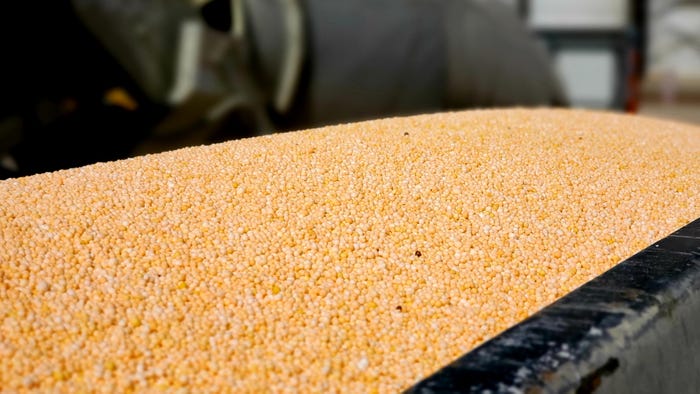Volatility, high prices expected for fertilizer
What is the fertilizer outlook for 2025? Take a look at what to expect and the role planning will play in the New Year.
Don’t expect fertilizer prices to ease up before spring planting.
Volatility will remain with tight supplies of nitrogen, phosphorous, and potash into 2025.
“Overall, fertilizer volume is expected to be down 15% to 20% year over year,” said Gregory Griffin, national fertilizer director, Wilbur-Ellis Company, College Station, Texas.
Griffin said prices for nitrogen, phosphorous, and potassium will remain volatile. “Expect prices to remain elevated through quarter two,” he said at the Texas Plant Protection Association annual conference Dec. 11.

Gregory Griffin, national fertilizer director, Wilbur-Ellis Company, College Station, Texas (Photo by Shelley E. Huguley)
He said nutrient volume will be down for 2025 compared to 2024 because of lower application rates and higher market prices.
He also expects less interest in pre-paying for fertilizer. Purchases are “price-driven,” he said, “so prepaid dollars will be down significantly given the farm economy and the need for liquidity.” Import restrictions and the depressed agricultural economy will be factors.
Griffin also noted logistic constraints could affect timely product availability and expects a reluctance to own stocks due to wholesale price risk.
He offered specifics on the three main fertilizer markets.
Phosphate
Griffin said phosphate volumes will be down this spring given prohibitive marketing pricing.
“Phosphate prices are being supported by tight global supply,” he said. Chinese, Moroccan, and Russian export restrictions are a factor. “Affordability has declined compared to potash and nitrogen. Price risk is extreme, and demand is low.”
He said higher phosphate production costs have triggered a global demand decline. “Supply constraints remain a challenge in the near term, tightening phosphate markets.”
Demand, he said, is likely to remain challenged with low commodity prices and the high cost and availability of dry phosphate.
Potash
Griffin said global potash demand the first half of 2024 was supported by favorable consumption trends in most markets. Low inventories exist in North America and Southeast Asia.
He added that settlement of contracts with China and India would support stable pricing. “Potash prices have been stable to stronger as destocking offshore markets and settlements and contract markets resulted in improved demand and price.”
Griffin said projections indicate potash exports from Eastern Europe will be down 7 to 9 million tons from previous levels. “Lithuania is not allowing Belarusian exports, which is 20% of the global market.”
Nitrogen
“The nitrogen complex is influence by higher prices,” Griffin said. “Feedstock requirements, global sanctions, and delayed purchases are factors. We see firm prices on all nitrogen products. Ammonia prices are influenced by volatile European natural gas supplies.”
He added that weak downstream industrial market demand has tightened, supporting higher prices. Urea nitrates have remained strong as offshore demand has been paired with North American demand.
Nitrogen volumes will be down year-over-year because of lower application rates and higher market prices, Griffin said;
As with many agricultural issues, China plays a role. “China remains defiant on urea exports, and China accounts for 30% of the global urea trade,” Griffin said.
Ammonia values remain high, and UAN values have continued to increase.
Regional demand
Griffin said regionally, the Cornbelt and the South have “large crops coming off, which, combined with soil mining, means nutrient deficiencies should be addressed. Prices for both grain and fertilizer are prohibitive and will be a drag on affordability,” he said.
Consequently, prepay dollars are expected to be down year-over-year. “(Fertilizer) consumers are choosing to remain as liquid as possible without tying up cash,” he said. “Cash constraints and higher interest rates will continue to affect the industry.”

Layering product acquisition will help mitigate price volatility and risk. (Photo by Shelley E. Huguley)
Griffin said the Western U.S. is “healthy on moisture. Fertilizer demand was healthy in California and the Pacific Northwest but at lower rates in the fall. NH3 demand was healthy on Pacific Northwest wheat.
“West Coast imports likely will remain limited given the global fertilizer price outlook and tariff restrictions,” he said.
Managing volatility
Griffin advises layering product acquisition to mitigate price volatility and risk. “The supply chain will continue to struggle into 2025,” he said. “Planning with suppliers is necessary to ensure equipment availability for timely delivery.
“The farm economy likely will be bearish on import input pricing,” Griffin said. “Grain prices and an appetite for nutrients will influence buying behavior and market direction. Expect producers to make purchases from retail companies just in time. The supply chain will continue to struggle into 2025.”
He said the global energy crisis will continue for the near future, creating a challenging logistics environment. “The industry will remain risk adverse.”






